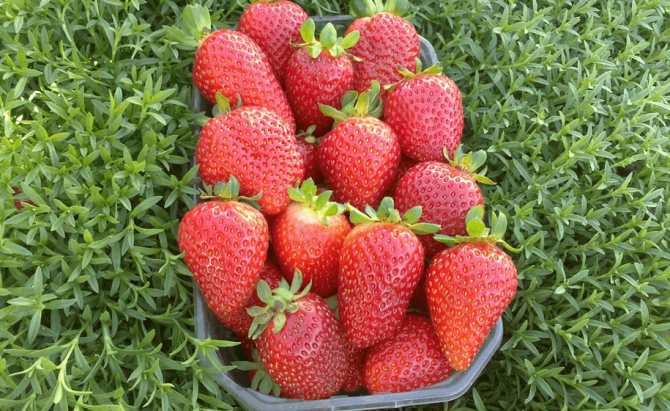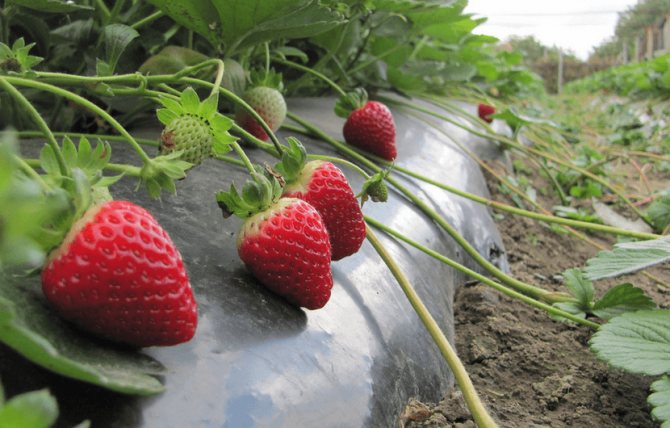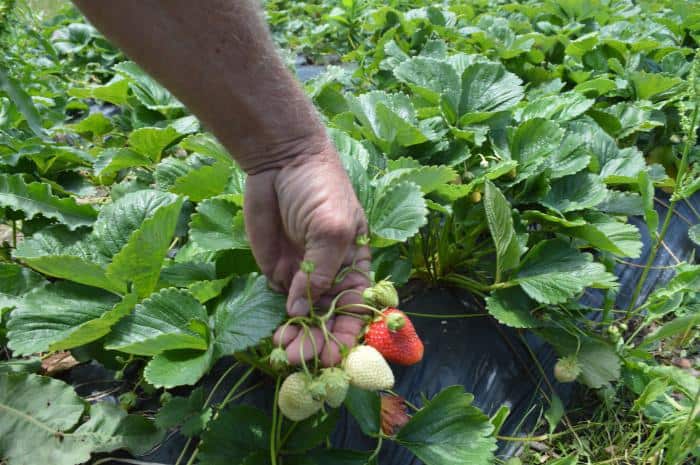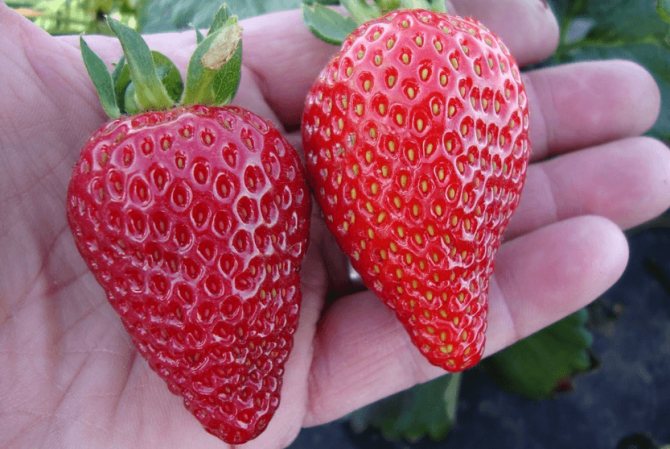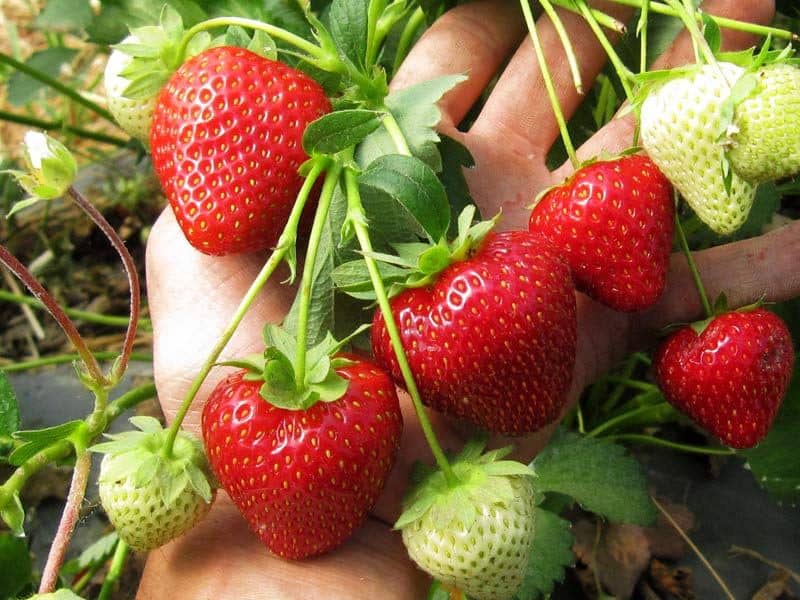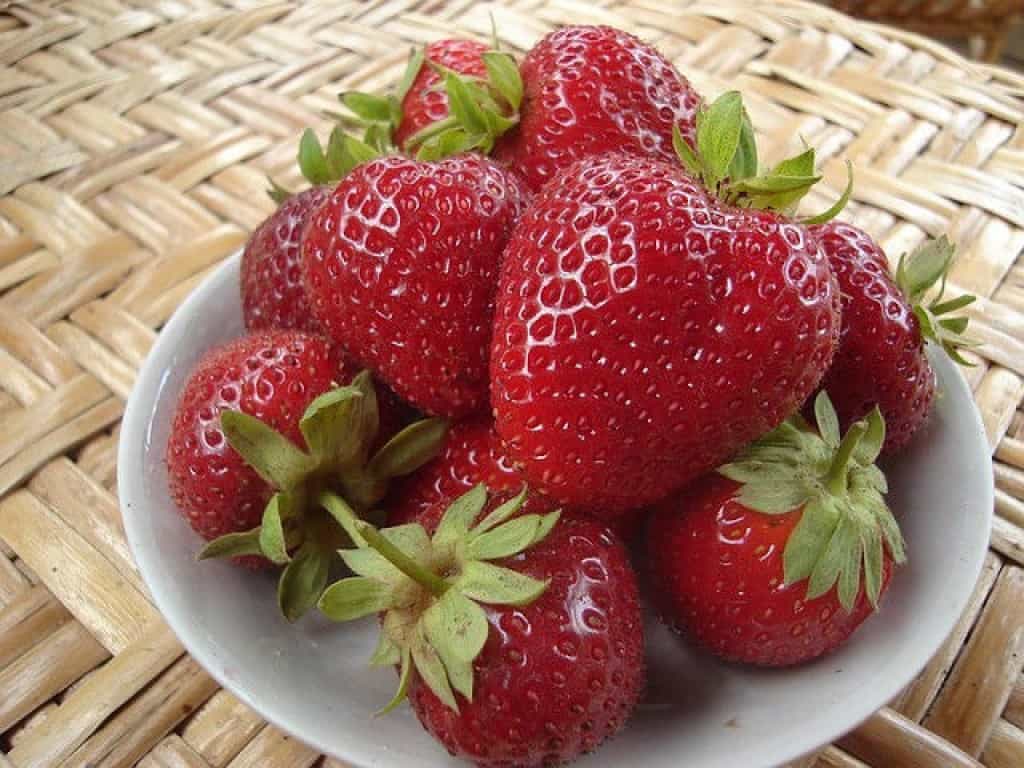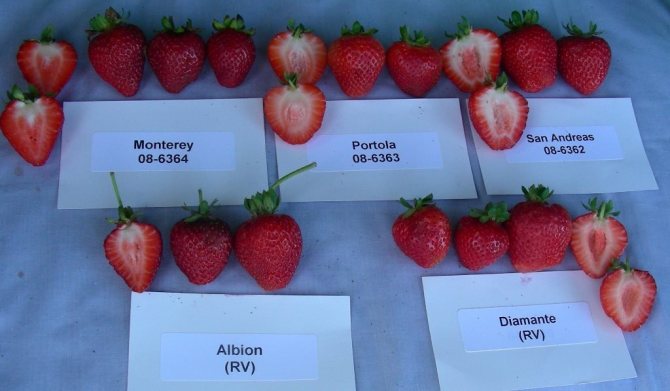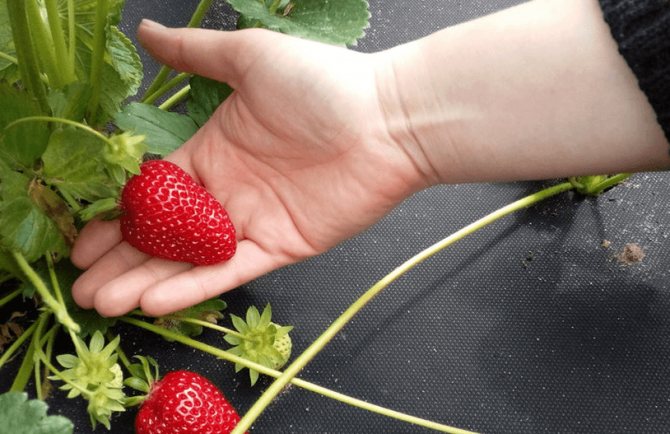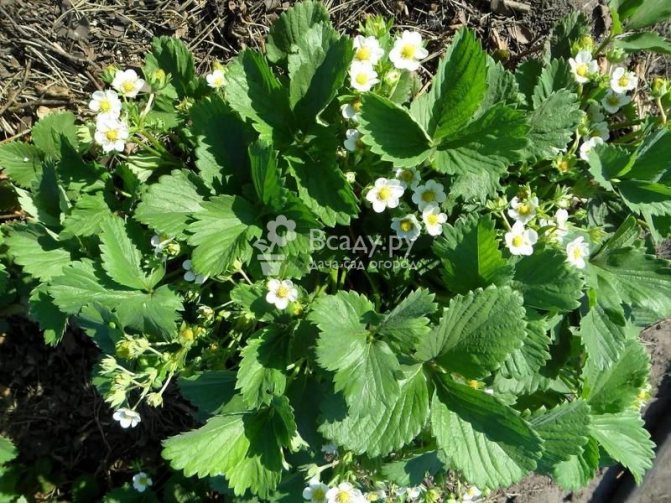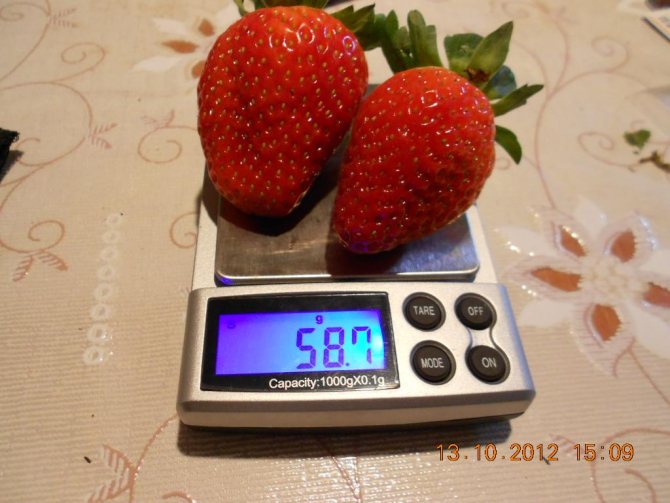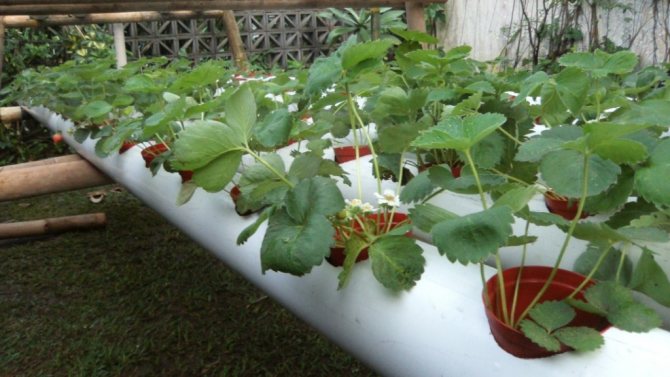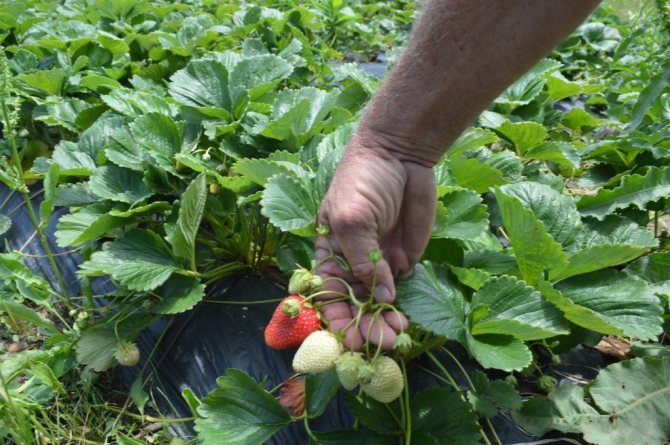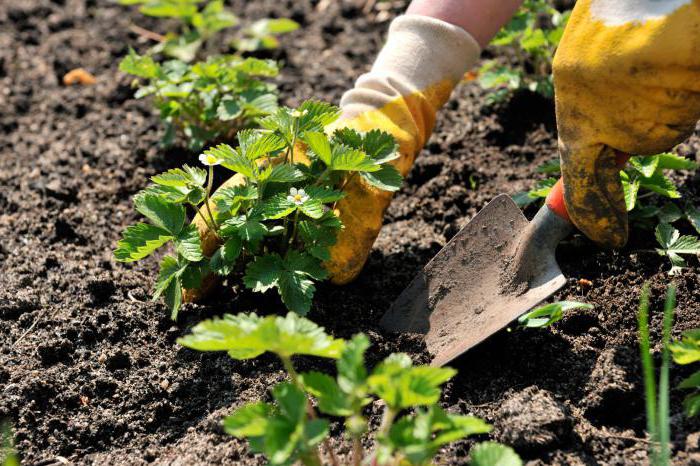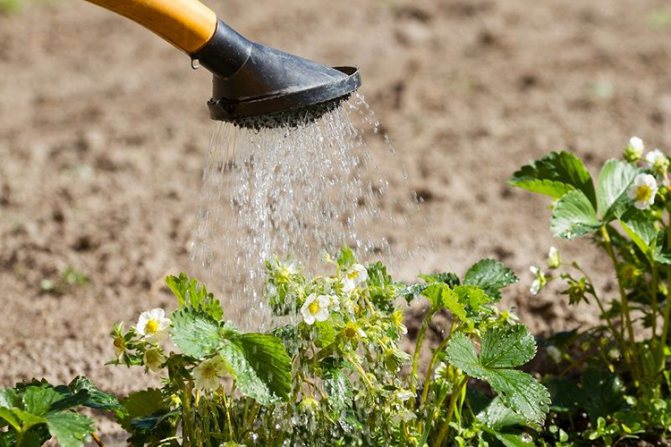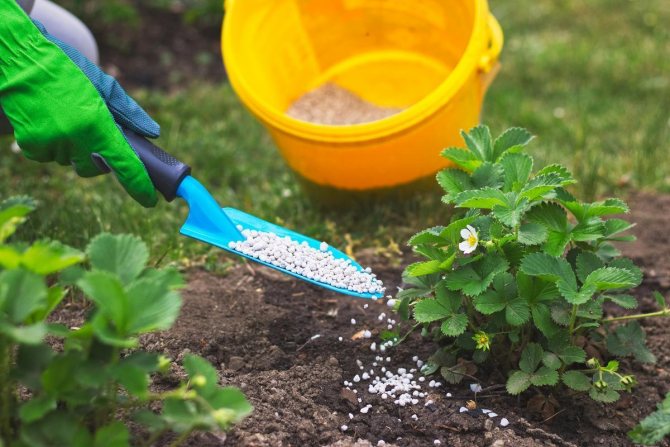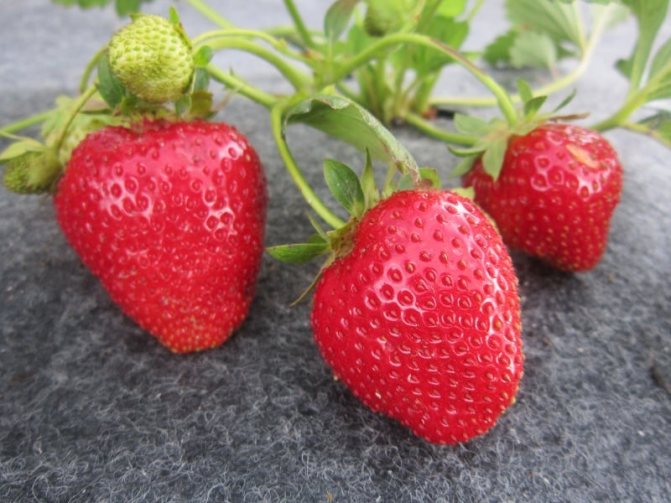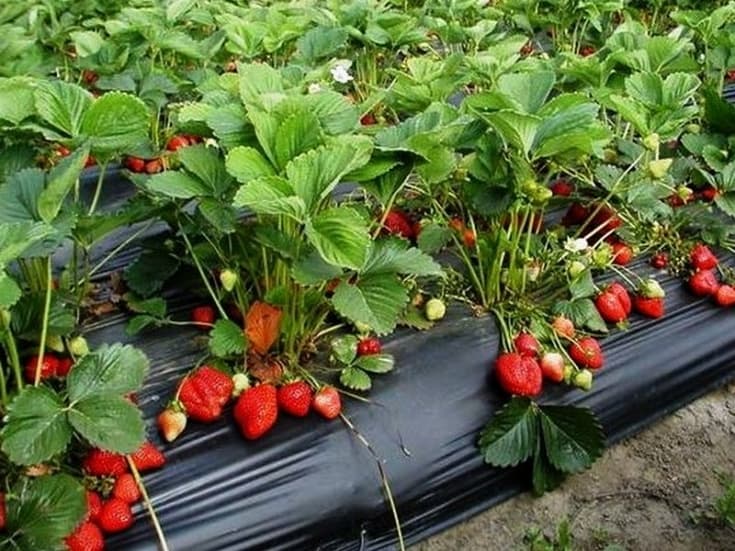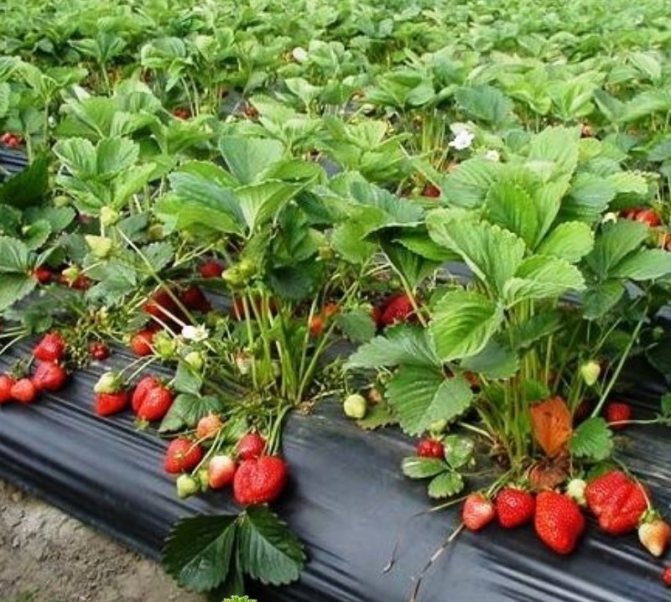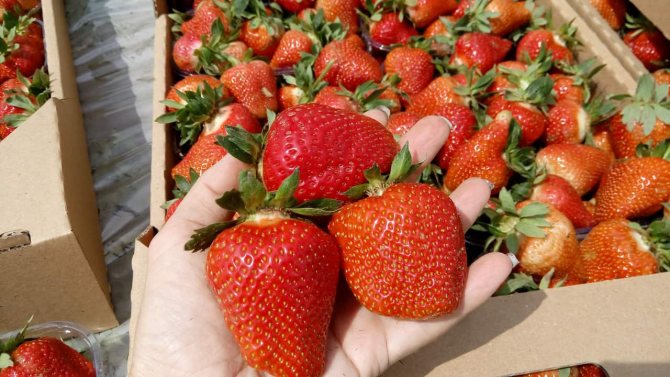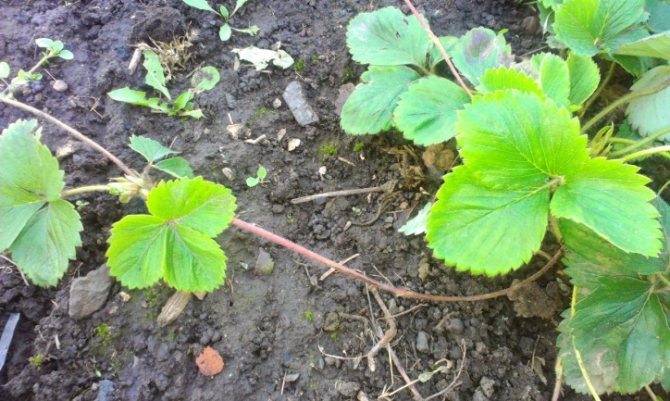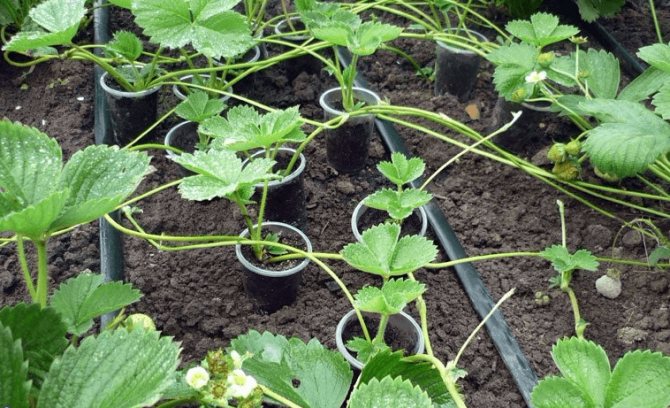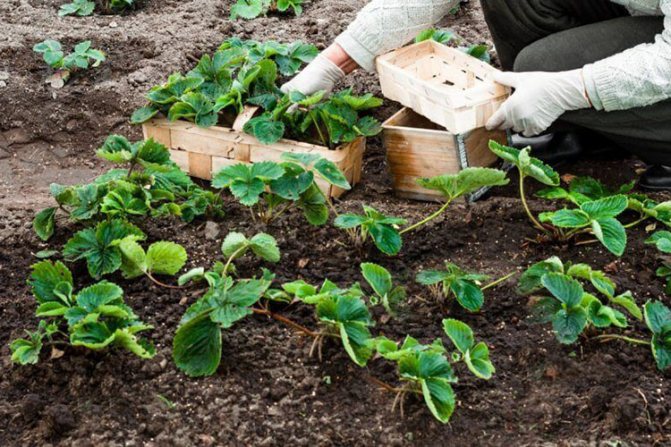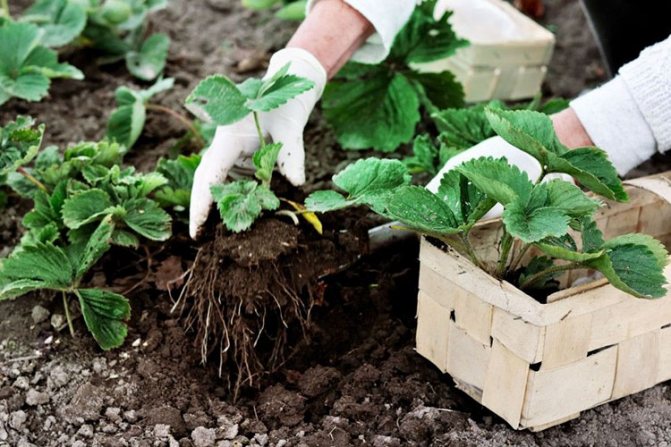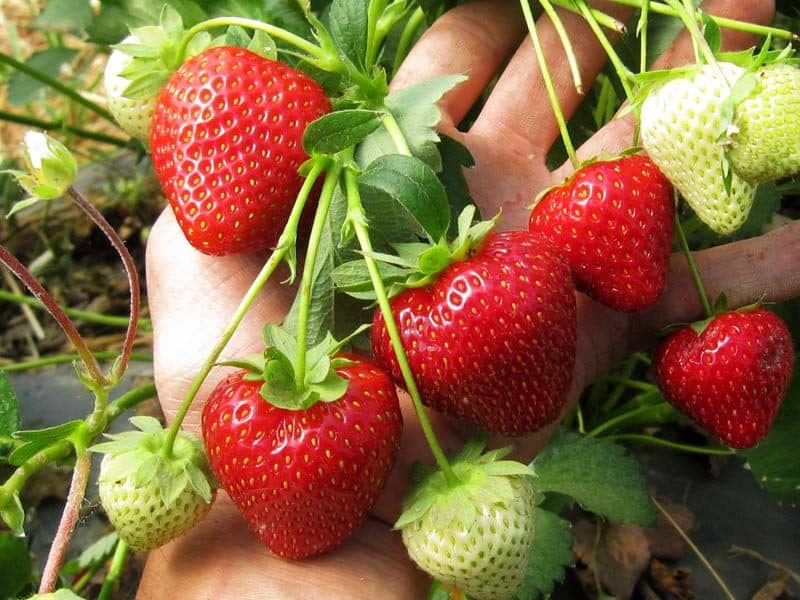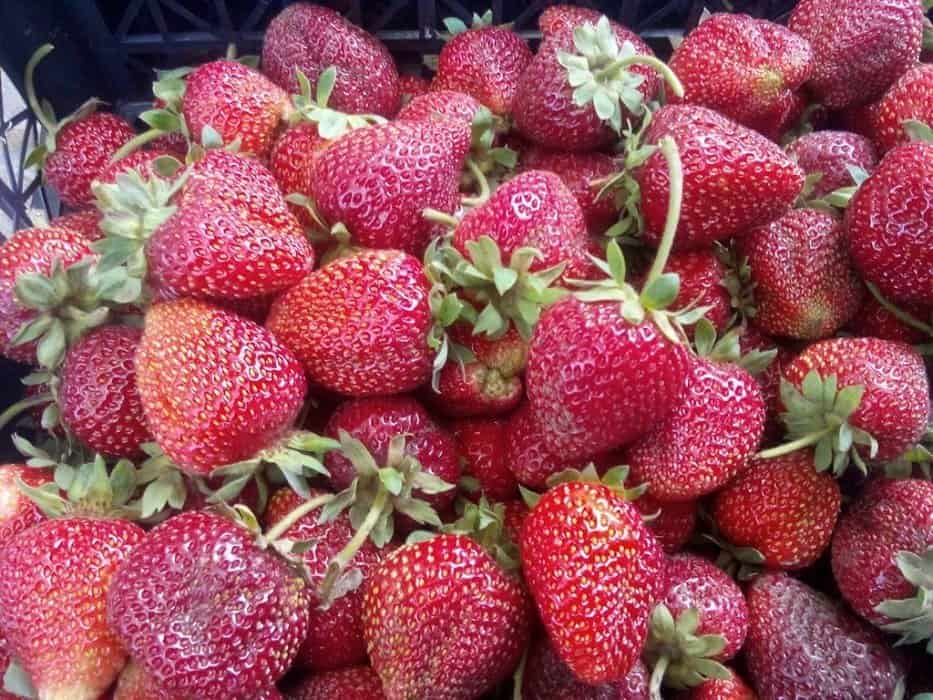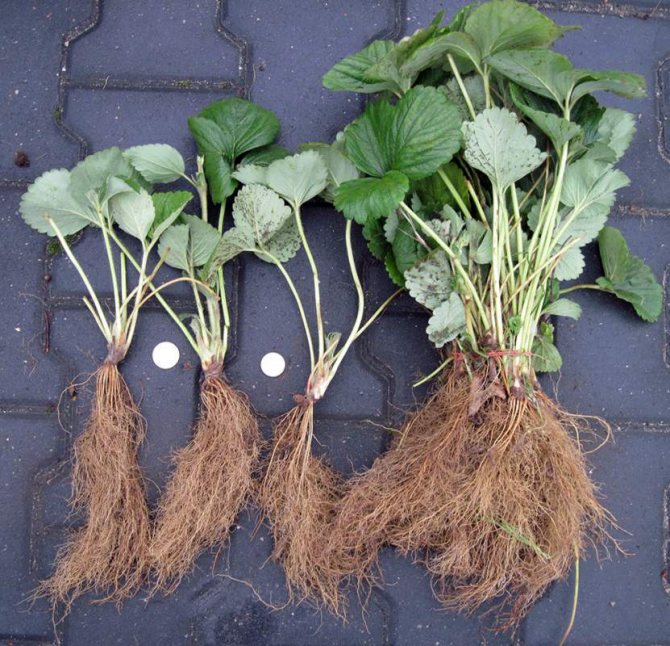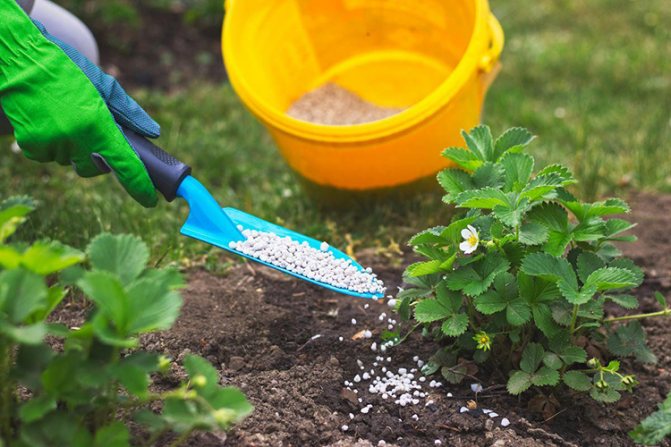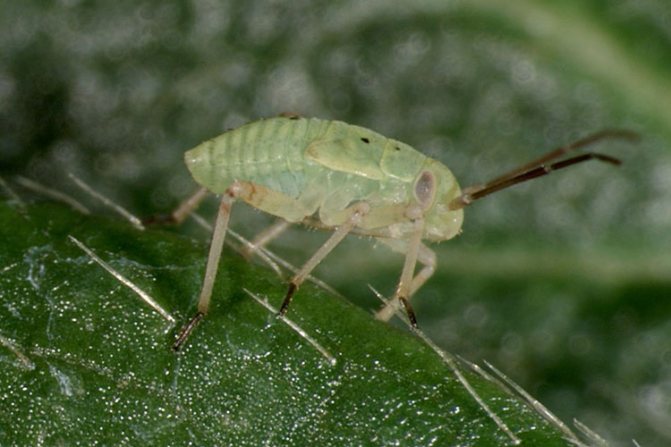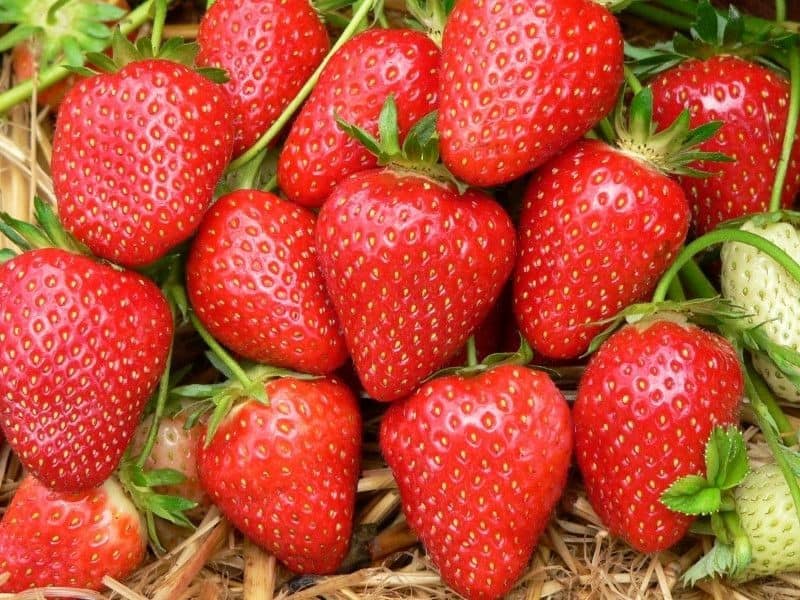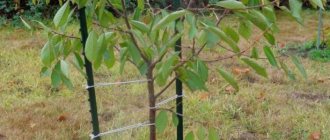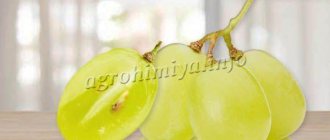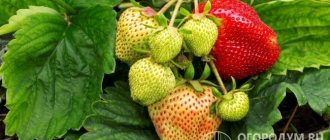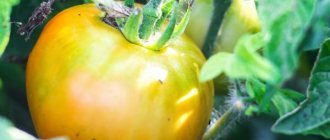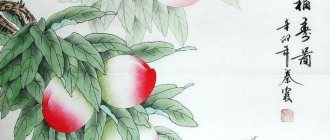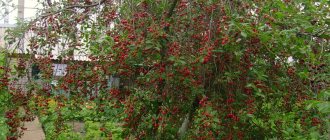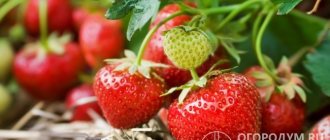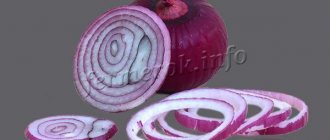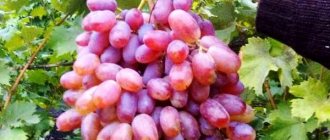From the many varieties of everyone's favorite garden strawberry, we want to choose the one that is ideal for our garden plot. In the variety, we should be satisfied with the taste and size of the fruits, their quantity, frost resistance, unpretentiousness, resistance to diseases and weather disasters.
Strawberry Albion - a description of the variety, photos, reviews of gardeners - exactly what gardeners are looking for. Beautiful, sweet and aromatic berries will delight you with an excellent taste throughout the summer period, since the variety, in addition to its many other advantages, is also a remontant one.
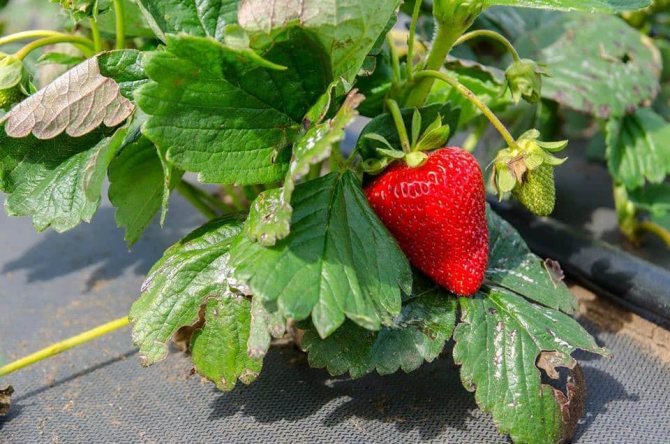
Pros and cons of the variety
Berries of strawberries Albion Advantages of the variety:
- In warm climates, a hybrid strawberry variety is capable of producing up to 4 harvests per season.
- A strong flower stalk allows you to keep the berries on weight, which protects against spoilage if the fruit is not picked on time or in bad weather.
- Albion is resistant to sudden changes in weather or ambient temperature.
- When growing this variety of strawberries, there is no need to use any chemical preparations to protect the plant from pests or diseases. Thanks to the work of Californian breeders, the plant is able to successfully resist them on its own.
Among the disadvantages, it is worth noting that:
- In the middle lane, the last harvest coincides with the first frosts, so it is recommended to grow it indoors.
- Breeding bushes with whiskers is not always possible when growing Albion. The variety is characterized by a low ability to release whiskers. Often new plants have to be grown from seed.
- The variety is characterized by low frost resistance, fruiting decreases at temperatures above 30 ° C.
History and description of strawberry Albion
The repairing variety Albion appeared in 2006 thanks to the work of Californian scientists. The strawberry was obtained by crossing Diamante and Cal 94.16-1 and intended for commercial cultivation. The new hybrid was originally named CN220.
Albion is a variety with neutral daylight hours. It is recommended for cultivation in the USA, Italy, and southern Canada. In the Russian Federation, the cultivation of this variety gives the best results in the southern regions (Crimea, Krasnodar Territory, Rostov Region). In the middle lane and northern regions, it cannot be grown in open ground, but it bears fruit perfectly in greenhouses, subject to high-quality lighting.
The variety blooms and forms ovaries continuously (in Russian conditions - from early May to October). When grown in greenhouses, you can harvest all year round. It starts bearing fruit in the second year after planting.
The neutral daylight variety Albion was developed in 1997 by breeders Douglas W. Shaw and Kirk D. Larson. The diamant varieties and the Cal 94-16-1 numbered selection were crossed. The resulting plants were numbered Cal 97.117-3 and planted at the University of California Wolfskill Experimental Orchard near Winters.
In the same place, in 1998, the first harvest was obtained, then asexual reproduction was carried out using the rosettes formed on the whiskers, which are given by strawberries. After selection and testing, the new variety was assigned the number CN220 and later given the name Albion.The word itself is of Celtic origin, denoting the ancient name of the British Isles.
In 1999, our hero was tested at the Watsonville Strawberry Research Facility, the South Coast Research and Extension Center, and limited planting of strawberries in the fields began. After the scientists were convinced that the varietal characteristics were fixed and preserved during subsequent reproductions, the registration procedure began and the testing of plants for various parameters continued. The first variety patent was obtained in 2004. Albion is officially owned by the University of California, USA.
When and how to plant?
- Plants are planted in spring in warm soil, the temperature of which is stable around 20 ° C.
- On the plot allocated for a strawberry plantation, holes are made no closer than 20 cm from each other, the distance between the rows should be at least half a meter from each other.
- A portion of a mixture of humus and sifted wood ash is placed in each hole. The mixture will provide the young plant with everything it needs for reliable rooting. Water each well with plenty of water just before planting.
- Seedlings are kept for several days in a dark, cool place before planting.
- Saplings are cut before planting. The root can not be longer than 10 cm. All peduncles are removed, it is allowed to leave only 3 leaves on the bush, so as not to distract it from the rooting process.
- Planting time should be in the evening or on a cloudy day.
If it is impossible to grow strawberries in the open field, you can use a greenhouse. In this case, the disembarkation time will shift slightly.
Characteristics of Albion berries
Before we start describing the Albion strawberries, let's learn to distinguish between two berries - strawberries and strawberries.
Experienced gardeners and even more beginners often confuse 2 plants, mistakenly calling the berry a strawberry. Outwardly, strawberries and strawberries are similar and it is not very difficult to confuse them, but they have a significant difference that gardeners need to know, especially if they want to grow an excellent harvest. After all, the agricultural technology and growing conditions of plants are different and they also bear fruit in different ways.
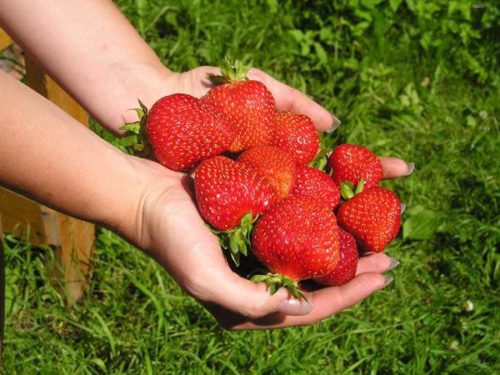

Gardeners often refer to strawberries as strawberries.
Strawberry bushes are much taller and more powerful than garden strawberries. Its peduncles are larger and rise above the leaf blades. Most garden strawberry varieties are dioecious. There are both male and female specimens. This specificity must be taken into account and when planting, alternate male pollinating plants and female bushes to obtain a good harvest.
Garden strawberries, on the other hand, are monoecious. By planting it on a plantation, you can be sure that absolutely every plant will yield a harvest. Strawberries are much more fertile than strawberries, the yield from one bush is greater, therefore, it is they who are most often planted by gardeners, still calling the plant strawberries.
The Albion strawberry variety was bred in the United States by agricultural specialists from the University of California and patented in 2006. The purpose of the creation was to obtain a variety for commercial cultivation. The Albion strawberry is zoned for the climate of America, but is successfully grown in Canada and Italy. It appeared on the Russian market quite recently, but Albion already has adherents and those who categorically did not like the variety.
Description of the variety
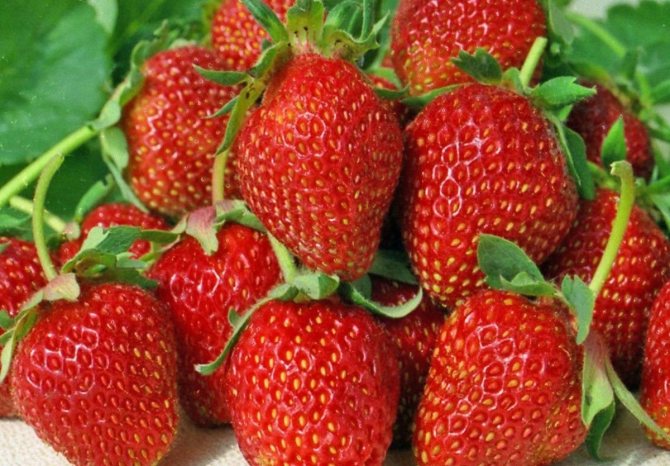

The strawberries of the Albion variety have several distinctive features. It is quite resistant to the most common diseases of strawberries: anthracnose and gray rot, it tolerates weather changes in summer quite well. On the other hand, it freezes out in frosty winters, does not like heat and dampness. At high temperatures during the fruiting period, it can completely stop tying berries, and with excessive moisture, the fruits become tasteless.
Albion is a remontant variety, it differs from similar ones in excellent productivity, the bushes bear fruit until autumn and from each one you can collect up to two kilograms of berries (under good conditions) per season. The fruits grow large, conical, glossy. Outside, they are colored deep garnet, and the flesh is a pleasant pink hue.
The bushes bear fruit until autumn and from one you can collect up to two kilograms of berries per season. Outside, the berries are painted in rich pomegranate, and the flesh of a pleasant pink hue. Berries are transportable and tolerate long-term transportation well
Berries of Albion grow large, weighing 50-60 g. In the first wave of the harvest, the berries are one-dimensional, in the rest of the fruits they become smaller, their dimension may be different.
The shape of the fruit is conical. The surface is bright carmine color, glossy, smooth. The berries begin to ripen from the tip. Often there are fruits with a light red color near the calyx.
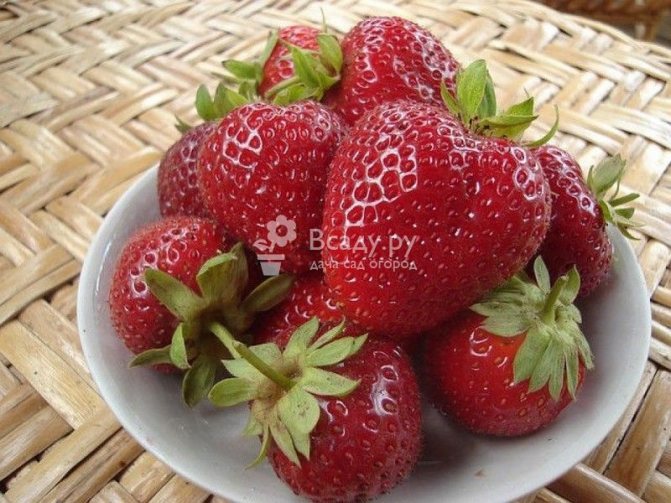

Albion strawberries
In the context, strawberries are deep pink in color, without voids. The taste is sweet and sour, and under favorable growing conditions and weather conditions, the acid is completely absent. Strawberry aroma is pronounced.
The flesh of the Albion strawberry is very firm, yet tender when consumed. Plucked berries retain their freshness for a long time, do not flow or wrinkle. Albion's transportability is one of the highest among other strawberry varieties. This feature of strawberries allows them to be successfully used for commercial cultivation.
Berries are used frozen, fresh and for processing. Due to the dense pulp when cooking jam, jams, compotes, Albion berries do not boil over and retain their shape.
The bushes of Albion are large - up to 40–45 cm high; they form a little mustache. The surface of large and dense dark green leaves is smooth, with an oily sheen. Strong, upright stems can easily support the weight of the berries, preventing them from touching the ground.
The berries are very large (average weight 30-50 g), conical or oval-elongated. Usually the first harvest (at the end of May) is characterized by one-dimensional fruits, and by 3-4 fruiting the shape of the berries can change to oval, heart-shaped or elongated.
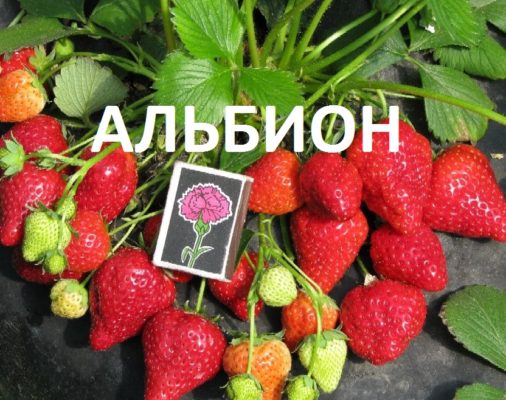

Albion berries are large, conical in shape, with a shiny surface
The taste of the fruit, according to gardeners, improves from the second wave of fruiting (second half of July). The color of the skin is bright red, with a gloss, the surface is even. The pulp is deep pink, dense, without voids, with a strong strawberry aroma. The berries are usually sour-sweet on the palate, and in suitable climatic conditions they are sweet, without sourness.
Advantages of the variety
The Albion strawberry, which has a long fruiting period, is rather large in size. Berries weigh from forty to sixty grams. They are bright, glossy, have a dark red color and a slightly oblong rounded shape. The large size of the strawberry is perfectly combined with incomparable taste. The dense berries are very sweet and aromatic.
The Albion strawberry forms a powerful bush. Non-lying peduncles are strewn with large white flowers. They protrude from the bright green foliage. This variety has a high yield. Under favorable weather conditions and proper intensive care, from four hundred grams to two kilograms of ripe dense berries are harvested from one bush. Moreover, with an autumn planting, the first harvest will be harvested already in the spring.
The drought-resistant qualities of the variety should be noted. Also, the relative frost resistance and disease resistance make cultivation and maintenance easier. Many people like the Albion strawberry. Reviews of gardeners who have this amazing variety in their collection note its high yield. He is able to satisfy the requirements of the most fastidious gardeners.
Will be able to provide large fragrant berries for the entire season Albion strawberries. Reviews of the owners of this variety indicate that with each wave of fruiting, its size does not diminish, and the yield does not decrease. In many respects, this variety is superior to other remontant analogues.
Care rules
The future harvest depends on the successful choice of location, soil preparation and compliance with the rules of agricultural technology.
For planting strawberries of this variety, the sunniest place on the site is required. The most suitable time for planting is late summer or early autumn, so that young rosettes take root, overwinter without problems and begin to bear fruit in the next season. Albion strawberries planted in spring may start producing berries, but the harvest will be poor.
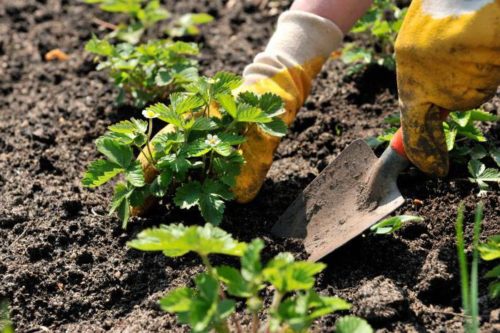

You need to plant Albion strawberries in a sunny area
An important procedure is preparing the soil for planting strawberries, since Albion is picky about a fertile substrate. Prepare the site in the spring if you plan to plant the plant in the fall, and, conversely, add organic matter in the fall when planning spring plantings. Add humus and well-rotted compost to the ground.
Soak strawberry seedlings before planting in a cool place for 7 - 10 days, such stratification will allow the plant to harden. Trim the roots just before planting. Moisten the garden bed. Mark the rows and dig small holes 0.5 m apart. Place a small mound in the middle of the hole, on which place the strawberry rosette. Spread out the roots and cover the entire space with soil, leaving the core on the surface of the soil. Moisten the plantings and mulch with straw.


Perfect for hydroponic cultivation. This new method allows plants to be cultivated without land, resulting in less disease. Match the containers for the strawberries and punch holes in them for the roots. Place a seedling in a container and fill all voids with a moisture-permeable material: expanded clay or coconut fiber.
When grown in a container, strawberries are fed by moistening the soil with a special solution with mineral fertilizers. It is very convenient and easy to care for strawberries grown according to this method, if you create a drip humidification system under the root, and you can also immerse a container with strawberries in a nutrient solution.
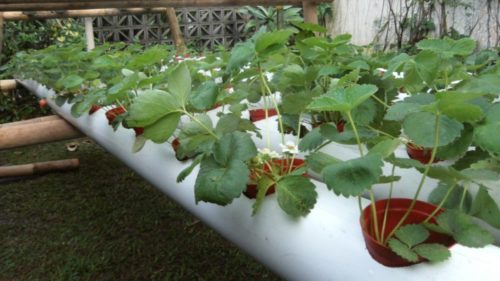

Great for hydroponic cultivation
This method is great for growing Albion strawberries in areas with very arid climates, poor soil or northern conditions. Also, hydroponic cultivation allows large amounts of crops to be harvested in a small area, since containers can be stacked vertically to save space. It is possible to grow strawberries in heated greenhouses all year round, getting the harvest regardless of the season.
A rich harvest, active fruiting quickly deplete the plant. The flavoring qualities of berries and their size are seriously reduced. To avoid such problems, you should follow a few simple rules of the gardener:
- All plants must be replaced 3 years after the first harvest.
- Bushes need good air exchange, which is achieved by regularly loosening the soil around them. When carrying out earthworks, it is important not to expose the root system.
- During the ripening period of the berries, regular abundant watering should be ensured, but the soil should not be waterlogged so as not to get fresh watery berries.
By calendar
- In the spring, after the snow melts and the soil dries up, it is required to clean the strawberry bushes from dried leaves, transplant the rooted mustache, and remove the plants that have not survived the winter cold.
- In the fall (from October to November) you need to help Albion prepare for the winter cold. Late fruiting will prevent him from doing it on his own.Peat, sawdust, fallen leaves and even straw can become a convenient and safe covering material. You just need to fill up each plant.
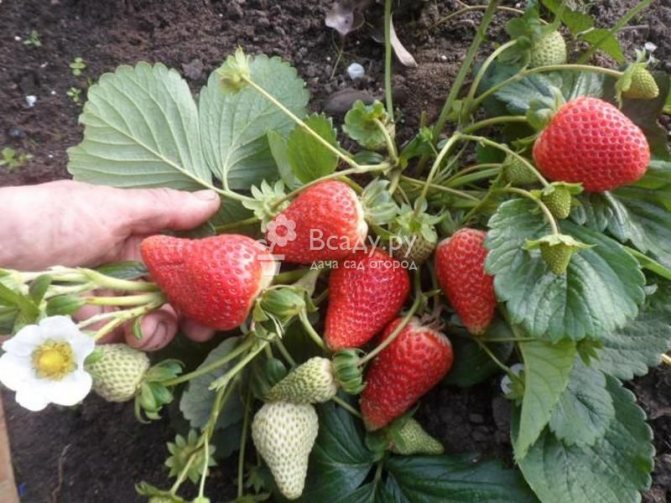

Albion strawberries need proper care. The taste and size of berries, as well as the volume of the harvest, depend on the quality of agricultural technology.
Outdoors Albion yields good yields only in the southern regions. Therefore, in the Moscow region, the variety is grown only in greenhouse conditions.
For planting, you need to choose the sunniest area. Even a little shading will significantly reduce productivity. The soil should be light and well fertilized with humus. With a high occurrence of groundwater, planting is carried out in ridges with a height of 30-40 cm.
Before planting, the seedlings are kept in a dark, cool room for 6 days. Long roots should be trimmed. Strong bushes require ample space to grow. In row spacings, a distance of at least 50 cm must be maintained, and in a row - 30 cm.
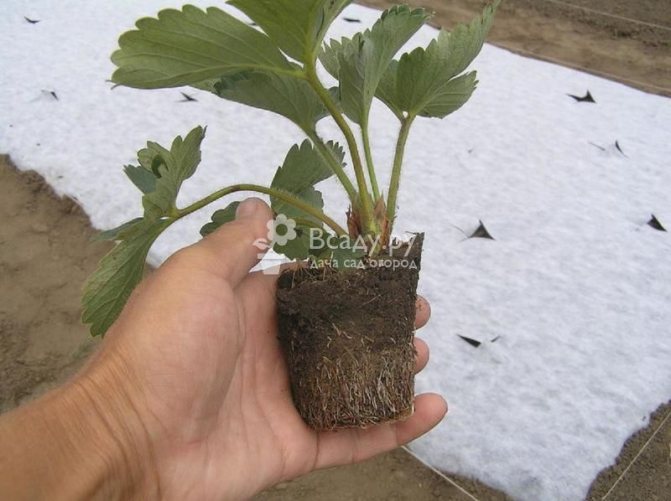

Strawberry sapling Albion
Planting is carried out in wet soil. It is better to do this in August-September, so that by winter the bushes can get stronger and give a full harvest in the spring. The emerging peduncles during this period must be immediately cut off. New beds are mulched with straw or sawdust.
A step-by-step description of planting strawberries in open ground is described in our material.
Albion strawberries are great for Dutch cultivation. Each seedling is planted in a separate container filled with a synthetic breathable substrate. Use coconut fiber, expanded clay or gravel.
You will find a detailed description of the Dutch method for growing strawberries in our article.
To obtain the harvest of Albion strawberries on an industrial scale, the method of growing in hydroponics is also used. A continuous supply of nutrient solution is provided to the roots of the seedlings by means of drip irrigation. This method of cultivation is justified in cold regions with poor and clayey soils.
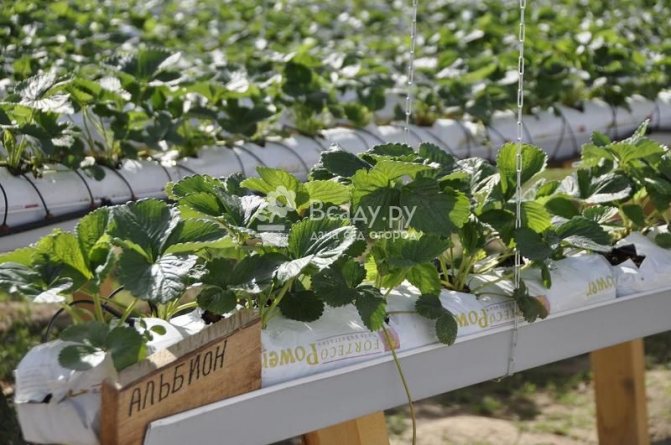

Strawberry Albion - hydroponic cultivation
You will find information on the method of growing in hydroponics in our material.
Care of the Albion strawberry variety is not specific. Like other varieties, it requires timely moderate watering (every 5-7 days). Overmoistening strawberries will lead to a loss of taste and the development of berry rot.
The beds after each watering require loosening and weed removal. Mulch or planting seedlings using Finnish technology - on black agrofibre - will help to simplify the care of strawberries. In this case, the weed does not grow, and the soil always remains loose.
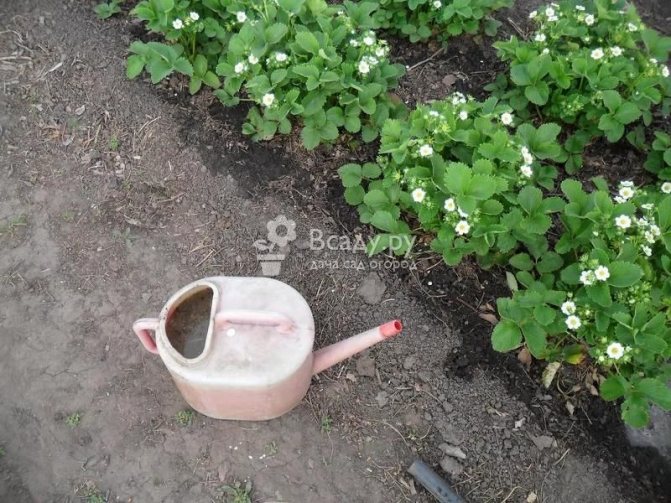

Care for Albion strawberries after watering
Before each harvest wave, strawberries are fed. She is responsive to the introduction of humus, slurry, chicken droppings, vermicompost. With early spring feeding, wood ash and a carbamide solution are added to organic matter, with late spring and summer - a complex of micro and macroelements.
Despite the resistance of the variety to some diseases, for the prevention of strawberries, Albion is treated with Topaz, Azocene preparations or a solution of copper sulfate (20 g per 10 l of water). For pest control, a solution of colloidal sulfur is used (60 g per 10 l of water).
The Albion strawberry reproduces with a mustache, dividing the bush and seeds. This variety gives a mustache very little, therefore reproduction by dividing the bush is most effective. Seed propagation is rarely used, since it is more laborious and the beginning of fruiting is postponed by one year.
Features of planting and care
Repaired strawberries of the Albion variety are propagated by antennae, dividing the bush and seeds. The most effective is the division of the bush, since Albion gives few whiskers, and with seed reproduction, fruiting occurs only in the second year.
- When propagating with antennae, cut off the processes, leaving only the first rosette. By August, it will be sufficiently rooted and a good seedling can be obtained.
- Cut it off with a clean knife from the mother liquor. Dig it out with a lump of earth and plant it in the so-called school (a bed for growing strawberry seedlings). They should be located at a distance of 10 cm from each other.
- In the spring, grown and strengthened strawberry seedlings can be planted in a permanent place. To do this, add humus to the soil and plant strawberries, digging out the seedlings from the school, without disturbing the clod of earth. If the roots are too long, they need to be shortened to 5–6 cm. Moisten and mulch the plantings. In the first year, strawberries grown from a mustache do not need to be allowed to bear fruit. She must grow a powerful root system.
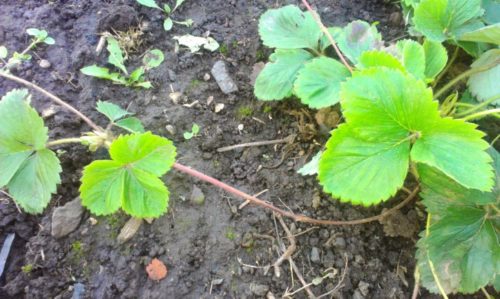

Only the first rosette on the antenna is suitable for reproduction.
- Soak Albion strawberry seeds for two days in melt water or rainwater. Change the water twice a day.
- Prepare a loose turf, sand and peat substrate. Pour it into a bowl and spread the soaked strawberry seeds on the surface. Spread them out gently with a toothpick. Do not sprinkle plantings with substrate on top.
- Cover the bowl with a plastic bag and send the container to the refrigerator for stratification. After 10-14 days, the container can be taken out and left in a warm place.
- Moisten the plantings without drying the top layer. As soon as the strawberry has two true leaves, the film can be removed.
- After 2 weeks, split the strawberries into separate pots. Plant in open ground in early June after the threat of frost has passed.
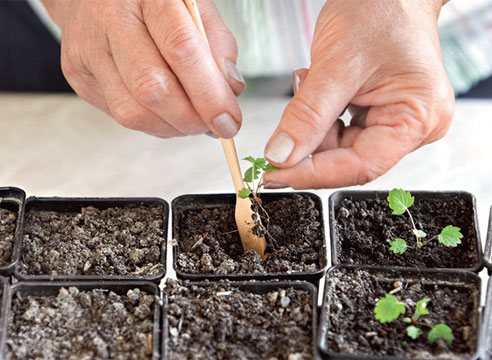

Dive seedlings carefully, they are fragile
This method is most effective for breeding Albion, since strawberry whiskers give little. For propagation by this method, choose mature, powerful bushes that can be divided into as many parts as possible. Delenki are best planted in late spring or August. At a later date, it is impractical to carry out the procedure for planting parts of the bush, since the roots will not have time to take root and will not survive the winter.
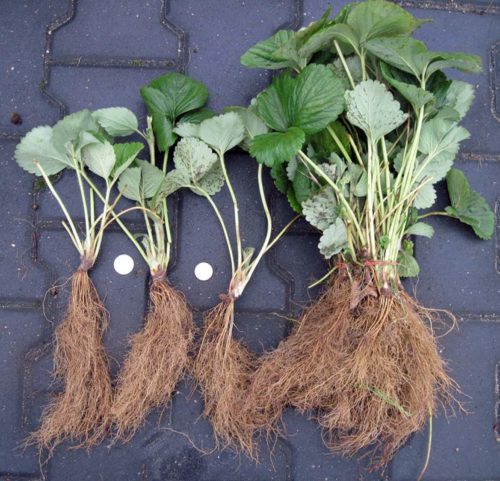

By dividing the strawberry bush, you can get several young specimens.
Divide the bush into several parts so that each division has a bunch of roots. Trim them a little and place them in a solution of potassium permanganate or fungicide for 2 hours. Plant on a garden bed in a school with thickened plantings (the distance between the divisions is not more than 10 cm). After 2-3 weeks, they are enough to take root and they can be transplanted to a permanent place in a fertile substrate. When planting, adhere to the 50x50 planting scheme, since the Albion strawberry grows into a fairly large bush.
Having one bush of the variety you like, you can provide the entire garden with planting material.
Reproduction methods
Of the traditional methods of breeding strawberries for the Albion variety, dividing a bush or sowing seeds is recommended, since little mustache is formed on plants.
- Division of the bush. It is necessary to take well-developed bushes at the age of 3-4 years and divide them into separate rosettes so that each has developed roots. You can divide it with a sharp knife or shovel, or you can soak the root system in water to separate the earth, and then carefully "pull apart" the bush with your hands.
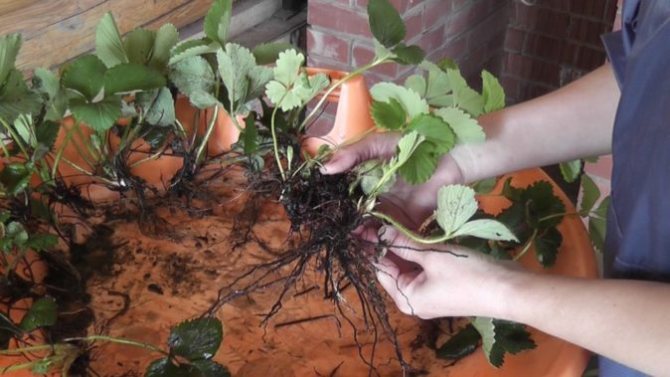

Soaking the roots will help separate the strawberry bush into separate outlets. - Sowing seeds. To obtain seedlings, fully ripe berries are collected, rubbed and washed out. The resulting seed is dried and stored in a refrigerator (shelf life - up to 1 year). Before sowing, the seeds are soaked for a day in water with the addition of growth stimulants (Stimpo, peat oxidate Strawberry, Energen). A full-fledged seedling (3-5 leaves, root collar with a diameter of more than 6 mm, minimum root length of 7 cm) is obtained with this method in 2 months.
Achieving a stable and rich harvest is possible only when growing healthy seedlings that have all the characteristics of the variety.
You can increase your plantation using one of the following methods:
- Growing a mustache.The young rosette must take root before its connection to the parent bush can be removed. In the first year of the mustache, all peduncles are removed to form a strong root system. It is allowed to take a mustache for transplanting only from strong healthy bushes that bear large fruits. Transplanting can be done not only in spring, but also in August or early September, in order to get a harvest from it next year.
- Division of a three-year-old bush. The works are carried out in the spring. The bush is carefully dug out so as not to damage the root system. The strongest part of the plant is used for planting. It will begin to bear fruit only next year. After transplanting, care should be taken to form a strong root.
- Growing from seeds. The process itself is quite troublesome, but only it can guarantee a plant that fully complies with all the characteristics of the variety.
Reproduction
There are three ways to propagate garden strawberries:
- Antennae (the most common).
- Seed (most time consuming).
- By dividing the bush (the roughest).
For the first option, it is advisable to use only the first-order sockets (closest to the bush), and immediately remove the rest. To quickly form roots, the antennae are pinned to the ground. After the formation of a good root system, the seedling is transplanted to a new place. If the mustache is not enough, which is quite realistic in the case of Albion, you can use the second method.
For harvesting seeds, the ripe, large berries of the correct shape are selected without any defects. From them it is necessary to carefully cut off the top layer with seeds with a blade and then dry and separate the seeds from the skin.
Of course, you can buy ready-made ones in the store, but:
- there is no guarantee that this is exactly Albion;
- the germination capacity of purchased seeds is usually lower than their own;
- yours is always more pleasant and interesting, plus invaluable experience.
Seeds for germination are laid out (laid out, not buried!) On peat tablets and create a microclimate with high humidity (covered with glass or transparent film). After 15-30 days, depending on the quality of the seeds and conditions, roots and leaves will begin to form. And in another month, it will be time to start picking (planting), and then landing in the ground. And since this process is quite long, it is necessary to start planting strawberries in advance, in March-April. Daylight hours at this time are still short, so it is advisable to highlight the plantings additionally.
In the most extreme case, the division of the bush is used for reproduction and the cut off part is simply transplanted.
Growing features
Albion can be grown at home, for this you need to pay attention to several important points:
- Capacity. Each shoot needs a pot with a volume of at least 3 liters.
- Priming. It can be a mixture of earth with humus or a special compound without using earth. Porous, moisture-permeable materials like crushed stone or coconut fiber are perfect for growing in the house.
- Watering. To obtain a harvest all year round, when growing strawberries of this variety at home, it is recommended to replace ordinary water and mineral dressings with a special water composition with mineral fertilizers dissolved in them.
The irrigation process itself can be traditional or hydroponic (the plant pot is placed in a container with liquid, allowing the roots to independently draw out the required amount as needed). - Oxygen access. All pots should have holes at the bottom to allow excess water to drain off during watering and to allow air to enter the root system.
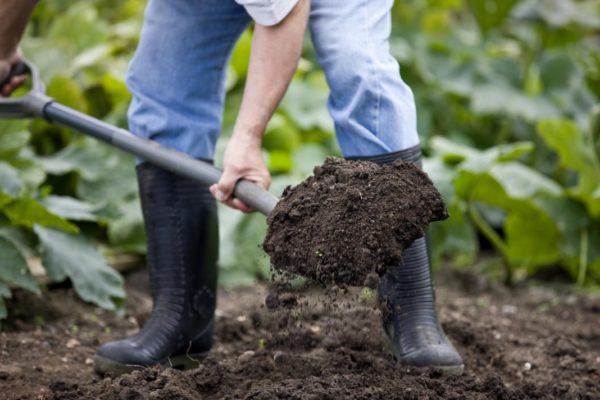

Although strawberries are not too whimsical, they need regular care in order to get good yields - watering, feeding, weeding, protection from pests.
Strawberries Albion reacts negatively to a lack of moisture - the quality of the berries deteriorates, voids may appear in them.At the same time, excessive watering is also harmful, provoking decay. Therefore, you need to water it regularly (every 12-14 days), but in moderation. Before flowering, it is recommended to water by sprinkling, then along the grooves. But the best way is drip irrigation, since the water goes directly to the roots.
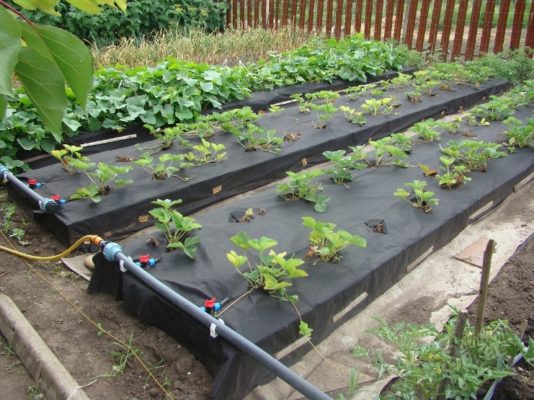

Tubes of the drip irrigation system are laid during the arrangement of the beds
The soil also needs regular maintenance. After each watering it is necessary to pluck out weeds and destroy the soil crust by loosening (10-15 cm between rows and 2-3 cm near bushes). You can save yourself from this tedious work by growing strawberries under a black film, but we must not forget that it sometimes provokes the spread of fungal diseases.
Regular feeding is very important for remontant strawberries of any variety, since the plant is constantly forming a crop. The best fertilizer is organic - solutions of mullein or bird droppings, compost, manure. It is recommended to feed strawberries with liquid solutions every 2-3 weeks.
Mineral fertilizers are applied 3 times during the growing season:
- At the beginning of the regrowth of young leaves, 0.5 l of urea solution (1 tbsp. L. Per bucket of water) is added per 1 bush or 50 g / m2 of nitrophosphate.
- Before flowering, plants are fed 2 tbsp. l. nitroammophoska and 1 tsp. potassium sulfate in a bucket of water (0.5 liters per 1 bush).
- In the fall, after the end of fruiting, 1 liter is added to the plant of a solution of 10 liters of water with the addition of nitrophoska (2 tbsp. L.) And wood ash (1 glass).
Strawberries respond well to foliar feeding:
- In the spring, when the leaves grow back, spray with a 0.1% solution of manganese sulfate, a 0.1% solution of boric acid, and a 0.05% solution of molybdenum-acid ammonium.
- In August, it is useful to carry out foliar feeding with urea (0.3%).
An important component of foliar dressing of strawberries is manganese sulfate.
Despite the good resistance to most diseases, preventive treatments will be useful. In particular, it is recommended to apply after snowmelt, and then during flowering Fitosporin or Glyocladin. You can also increase resistance to diseases with the help of a soap-iodine solution (30 drops of iodine and 35–40 g of laundry soap in a bucket of water).
To protect against pests, preventive or therapeutic treatments will be required:
- You can get rid of strawberry mites with a solution of colloidal sulfur (55-60 g per bucket of water).
- Pollination with ash or metaldehyde (3-4 g / m2) before flowering and after harvest will help with slugs.
- From nematodes can be treated with strong insecticides (Dinadim, BI-58). Better yet, destroy infected bushes. If the cuttings become short and deformed, and the leaf plates are twisted, you need to dig out the bush with the roots and burn it.
Typical diseases and pests - table
| Disease or pest | Signs | Control methods |
| Strawberry mite | It has an oblong-oval white body; over time, the insect acquires a yellowish tint. The pest eats young leaves. The leaves become wrinkled and oily to the touch, the berries become smaller. | In early spring, when the first leaves are just beginning to appear on strawberries, the infected plants should be treated with gray colloidal, the solution of which is made at the rate of 2 matchboxes (50-60 g) per 10 liters of water. |
| Nematode | The cuttings are short, deformed, the leaf blades are twisted. | The affected strawberry bushes should be carefully dug up, trying to remove the entire root system and burn. |
| Slugs and snails | Damaged berries. | Treat strawberries before they bloom and after harvesting with Metaldehyde (3-4 g per m2). |
| Fusarium wilting of strawberry bushes | On the edges of the leaf blades, necrosis appears - brown spots, damaged leaves become lethargic, acquire a brown tint, and then die off. |
|
| Powdery mildew | The berries are ugly, covered with a gray coating, a mushroom taste and smell appears. |
|
Photo gallery: strawberry pests
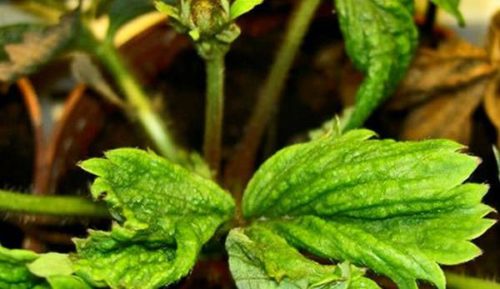

Leaves affected by strawberry mites look deformed
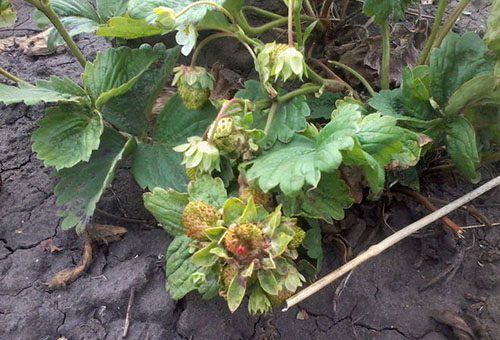

The plant cannot be cured, it must be removed and burned
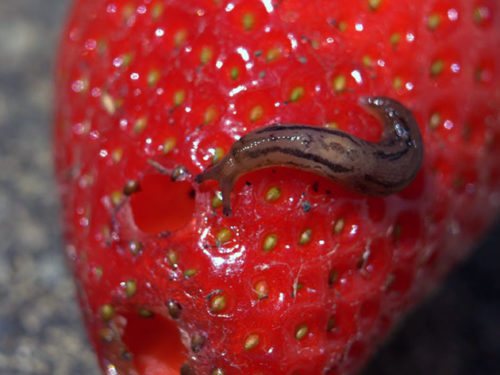

Slugs and snails love to feast on berries.
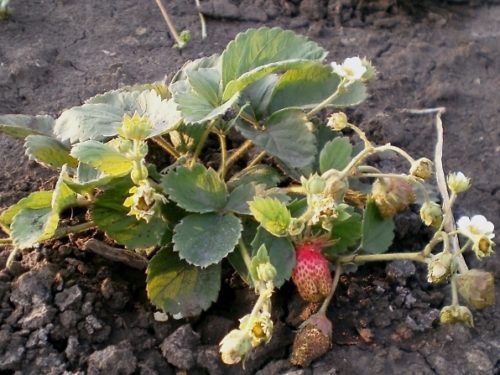

To prevent fusarium rot, do not grow strawberries in one place for more than 4 years.
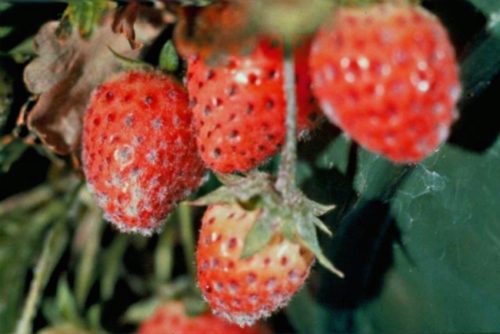

Berries affected by powdery mildew are covered with a gray coating
How to harvest and preserve crops
Garden strawberries are one of the most perishable berries. Harvesting and preserving a crop is a whole science; it is not for nothing that many gardeners ask this question: not only experienced, but also beginners. The Albion strawberry is a remontant variety that bears fruit all season, so you need to collect it regularly.
If you do not plan to serve the berries right away, and you need to store it for some time, it is advised to start picking about two days before full ripeness, when the berries are still pinkish. In this case, they can be stored in the refrigerator for 2-3 days. Remove berries intended for transportation, together with sepals and small tails. Do this in the morning, but after the dew has dried.


Berries are best eaten immediately after harvest.
Put the removed strawberries in plastic boxes, covered with a soft cotton cloth, gauze is perfect for this. To prevent the fruits from softening during transportation, stack the strawberries in one layer. Cool the harvested crop to 0 ... 2 ° C. Try to do this as early as possible after harvesting, chilled fruits can lie in the refrigerator for up to 3 days.
Shock freezing will help keep strawberries fresh for a long time. Arrange the clean berries on a platter and place in the freezer. When they have hardened, transfer to a plastic bag or plastic container. Thus, the strawberries will not stick together and you will be able to get exactly as many berries as you need to consume at one time.
When cultivated outdoors, the Albion variety usually produces 4 crop waves:
- At the end of May.
- Early July.
- Mid August.
- In the second half of September.
Strawberries are harvested by hand, in the morning or evening, in dry weather. The berries must be picked together with the stalk and placed in boxes or buckets. Unlike other varieties, Albion withstands laying in a thick layer, practically does not wrinkle. The crop is stored in the refrigerator, where it can retain its freshness and taste for 7-8 days.
Strawberries of this variety are very good fresh, and are also recommended for making jam, since the dense berries retain their shape when cooked. But, of course, you can use the crop for other purposes as well - fruit salads, punch, compote.
Strawberries are an excellent raw material for pears and other drinks.
We must not forget about the medicinal properties of strawberries. Berries help to improve metabolism, have a urinary and diaphoretic effect. Decoctions and infusions of strawberries help with stomatitis and pharyngitis. Infusions of the leaves help lower blood pressure and have a hemostatic effect. Even the roots are used - their decoctions are used for colitis and hemorrhoids.
Description of fruits
Albion can delight the gardener with large berries weighing 60 grams. At first, the harvest is equal in size, but gradually becomes smaller. After the first harvest, the harvested strawberries may vary in size.
The berries are conical in shape. The surface is smooth and shiny. Aging starts at the tip. The pulp has a pleasant pink color, there are no voids. Strawberries taste sweet with sour notes, and if grown in good conditions, then there will be no sourness at all. In addition, the fruit has a pleasant scent.
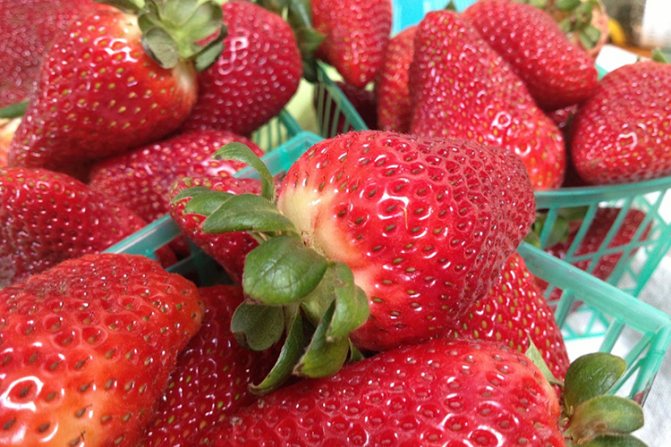

It is worth highlighting the good transportability of the fruits. She is one of the best among the representatives of this culture. Due to this, Albion is often used commercially. Tasting score - 4.5 points.
The crop is suitable for fresh consumption, freezing, you can cook jam, jam or compote. Also, berries are often used for cosmetic purposes.
Real reviews
Natalya Ivanovna, pensioner There is always a place for creativity and experimentation at the dacha. My new research a few years ago was the Albion strawberry. It was difficult to allocate a place on the site, and I was afraid for the safety of the plant in the winter, so I planted the seedlings in small containers. I was advised to use not soil, but mineral fertilizers and peat. I watered it regularly and at the end of June I tried the first berry. For the winter I put the containers in the basement, and in the spring I return them to the sun. All the neighbors are jealous that I can enjoy the fragrant berries much longer than they do.
Peter, 26 years old
Last year I had to look after the parental garden alone. Most worried about the strawberries Albion. We grow it on agrofibre. Its berries are large and very bright, therefore, against a dark background, they are clearly visible to birds. As soon as the bushes began to bloom, the parasites began to fly in to check in whole flocks. I have a few bright red glass stones left from the aquarium. I scattered them next to the strawberries. Having burnt themselves several times with blende, the birds did not touch the berries and sweat. This year the experiment was repeated - the result is still excellent.
Tatyana Valerievna, 52 years old
I have five grandchildren. All of them come to visit for the summer and everyone tries to go out to "graze" the strawberry beds as early as possible. Then grievances begin that someone did not have enough, etc. I was looking for a variety with a high yield. I stopped my choice on Albion. These berries do not fall to the ground, remain clean and do not spoil, even in wet weather. There are really a lot of berries, so even children, and not only grandchildren, have time to gorge themselves on it.
Reviews of gardeners about the Albion variety
Despite its industrial focus, the Albion variety has taken a strong position in private plots. Strawberry Albion has mixed reviews, we have selected the most interesting for you:
“I have been growing Albion strawberries for the fourth year in the open field. At first, there were many problems - the bushes were withered, covered with spots, did not bear fruit. This continued until she covered the flower bed with black covering material. Weeds, pests and diseases were gone. It became easier to water and harvest. "
Semenova Inna Ivanovna, gardener
“I really like the Albion variety, but I cannot grow strawberries in a greenhouse, and during the rains, the taste of berries often deteriorates - they become watery and lose their firm structure. She also noted that in the summer, the berries are tastier than in the spring. Yields are consistently good only with regular feeding. "
Toropov Nikita, gardener
“I did not like the capriciousness of the Albion variety - a low threshold of frost resistance, vulnerability to diseases and pests. In addition, the berry can completely stop fruiting in extreme heat. We got exhausted with this berry, so we switched to more resistant varieties with similar characteristics: Ostara, Rugen, Corona. But, unfortunately, they are inferior in size and taste of fruits, and yield. "
Vasilets Andrey, gardener


Growing strawberries Albion on black covering material
“I also faced various problems for a long time, but my friends advised me to make a simple greenhouse under the film or cover the beds with covering material. I tried both methods and got a great harvest. Last year I took a chance to test hydroponic cultivation, got an even bigger crop and started selling berries, there are so many of them now. "
Yuri Kravtsov, gardener

